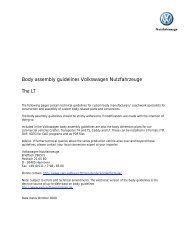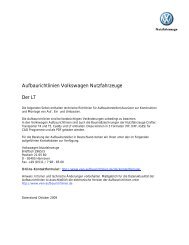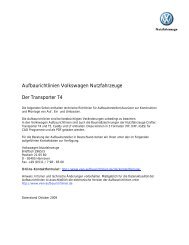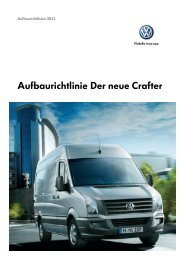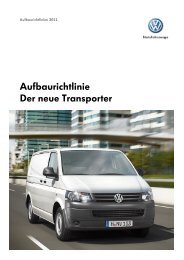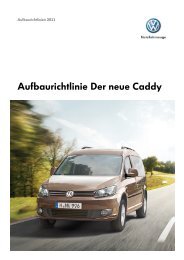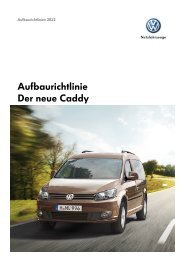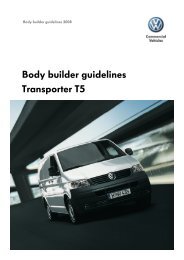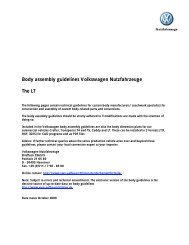Body assembly guidelines Volkswagen ... - Aufbaurichtlinien
Body assembly guidelines Volkswagen ... - Aufbaurichtlinien
Body assembly guidelines Volkswagen ... - Aufbaurichtlinien
You also want an ePaper? Increase the reach of your titles
YUMPU automatically turns print PDFs into web optimized ePapers that Google loves.
<strong>Body</strong> <strong>assembly</strong> <strong>guidelines</strong> <strong>Volkswagen</strong> Nutzfahrzeuge<br />
The Transporter T4<br />
The following pages contain technical <strong>guidelines</strong> for custom body manufacturers/ coachwork specialists for<br />
construction and <strong>assembly</strong> of custom body-related parts and conversions.<br />
The body <strong>assembly</strong> <strong>guidelines</strong> should be strictly adhered to if modifications are made with the intention of<br />
doing so.<br />
Included in the <strong>Volkswagen</strong> body <strong>assembly</strong> <strong>guidelines</strong> are also the body dimension plans for our<br />
commercial vehicles Crafter, Transporter T4 and T5, Caddy and LT. These can be installed in 3 formats (TIF,<br />
DXF, IGES) for CAD programs and as PDF files.<br />
Advice: If further technical queries about the series production vehicle arise over and beyond these<br />
<strong>guidelines</strong>, please contact your local conversion expert at your importer.<br />
<strong>Volkswagen</strong> Nutzfahrzeuge<br />
Brieffach 2965/5<br />
Postfach 21 05 80<br />
D - 30405 Hannover<br />
Fax. +49 (0)511 / 7 98 - 85 00<br />
Online contact: http://www.vwn-aufbaurichtlinien.de/de/kontaktformular<br />
Note: Subject to errors and technical amendments. The electronic version of the body <strong>guidelines</strong> is the<br />
decisive source of up-to-date data on body <strong>guidelines</strong><br />
http://www.vwn-aufbaurichtlinien.de<br />
Data status October 2009
At the box-type delivery van/station wagon, attachment and base group form a self-supporting unit. Supporting parts of<br />
this self-supporting unit must not be removed without being replaced by another component.<br />
Baffles have no supporting function. Modifications, even the complete removal, are permitted.<br />
A. Cut-outs in the side wall<br />
Since the subsequent installation of windows is complicated and expensive, it is recommended to order the desired<br />
windows ex works (see delivery program).<br />
Cut-outs for windows, doors, tailboards, ventilation, etc., may only be realised between the supporting parts (pillars,<br />
roof chassis and floor). Supporting parts must not be cut or weakened. The cut-outs are to be provided with a<br />
continuous frame which is to be connected force-locking with the bordering supporting parts.<br />
Retrofitting of windows<br />
If windows are to be retrofitted, the following operation method can be implemented:<br />
1. Cut out the exterior plate along the window case of the interior plate and insert, for example, a pane with the<br />
corresponding rubber seal (accessory parts). The serial differences between box-type delivery van and station wagon in<br />
the window area are represented below.<br />
2. Prepare the window cut-out according to the series requirements. Insertion of standard panes. Details on the procedure<br />
are available on request.<br />
3. If you desire smaller windows than shown below, the following applies: In general, the cut-out may only be realised<br />
between the pillars. Supporting parts must not be cut or weakened. The cut-out is to be provided with a frame which is<br />
to be connected force-locking with the bordering supporting parts.
Note: Subject to errors and technical amendments. The electronic version of the body <strong>guidelines</strong> is the decisive source of up-to-date data on body <strong>guidelines</strong> (online body<br />
<strong>guidelines</strong>). Data status August 2007
Roof cut-outs to prepare the subsequent attachment of vent roofs, pop-up tops and high roofs are currently not available<br />
ex works.<br />
B. Retrofitting of Roof Cut-Outs<br />
1. It is possible to realise roof cut-outs between the bows and the lateral roof chassis. For details, see below.<br />
2. Roof cut-outs between bows B and C are only permitted at wheel base 2,920 mm. Details on the max. possible roof<br />
cut-out permitted in this situation, see section 3.3 Modification of closed attachments. The cut-out must be provided with<br />
the specified reinforcing plate at the left-hand and right-hand side. Both reinforcing plates are to be welded to the roof, the<br />
B- and C-bows as well as to the bow stubs of the bow which has been cut out (between B- and C-bow).
3. Large roof cut-outs for normal roof versions and both wheel bases to retrofit high roofs and pop-up tops. - Only for<br />
vehicles with max. sliding door -
On the left-hand and right-hand side, the large roof cut-out is limited in the passenger compartment/boot space by the<br />
sheet edges of the lateral roof chassis (see sectional view A-A). In the rear area, the cutting edge runs along the edge of<br />
the D-cross-beam interior plate (see sectional view B-B).<br />
Schnitt A-A 90° gedreht.<br />
Schnitt B-B<br />
Cutting plane line in the cab area (starting at front edge of B-bow) according to the above drawing specifications.<br />
The continuously running cutting plane line is to be ground and treated with an anticorrosion agent.<br />
Note: Subject to errors and technical amendments. The electronic version of the body <strong>guidelines</strong> is the decisive source of up-to-date data on body <strong>guidelines</strong> (online body<br />
<strong>guidelines</strong>). Data status August 2007
C. Pop-Up Tops<br />
Subsequent mounting of a pop-up top with large roof cut-out (wheel base 2,920 mm)<br />
1. For the above mentioned roof cut-out (see draft in section B3), a complete <strong>assembly</strong> set for reinforcing the roof<br />
frame (including installation instructions) is available from Westfalia company, Rheda-Wiedenbrück.A two-part base<br />
plate is also included in this supply scope.<br />
The rear base plate, built in permanently in the area of the C-/D-pillar, is a supporting part. It is used for reinforcing the<br />
roof frame!<br />
It is not permitted to remove this rear base plate.<br />
In the passenger compartment, a base plate - made of a multi-layer adhesive bond wood-plate (minimum<br />
thickness 12 mm) - has to be additionally screwed in or bonded in.<br />
This construction was put to the test by us and ensures maximum stiffness of the car body.<br />
If other roof frame reinforcement sets (i. e. not the one from Westfalia co.) are to be used, it has to be ensured<br />
that the moment of resistance corresponds to that of the Westfalia set.<br />
2. Optionally, it is also possible to limit the roof cut-out only to the passenger compartment (starting at the rear edge of the<br />
B-bow; B-bow and cab remain unchanged). It is then possible to omit the trapeze for the cab area can from the Westfalia<br />
roof frame reinforcing set. In this case, it is required to realise a force-locking connection of the lateral roof-frame<br />
reinforcing parts to the bow foot of the B-bow with the help of junction plates. The base plate mentioned in section C1 to<br />
be used in the area of the C-pillars is also part of the roof-frame reinforcement. It is not permitted to remove this base<br />
plate.<br />
Note: Subject to errors and technical amendments. The electronic version of the body <strong>guidelines</strong> is the decisive source of up-to-date data on body <strong>guidelines</strong> (online body<br />
<strong>guidelines</strong>). Data status August 2007
C. High Roofs<br />
Subsequent installation of a high roof<br />
(Wheel bases 2.920 and 3.320 mm)<br />
1. Preconditions<br />
a) The max. roof cut-outs may correspond only to those mentioned in section B3 of this construction guideline - the same<br />
applies to the California. (see draft in section B3)<br />
b)The base vehicles may only be provided with max. one sliding door. In addition, it is not permitted to remove or weaken<br />
any supporting parts - apart from the max. permitted roof cut-out. This applies also to the additional retrofitting of high rear<br />
double-wing doors, a 2nd sliding door or changing to high sliding doors, etc.<br />
2. Deviations of the Preconditions Valid for Pop-Up Tops<br />
a) The roof frame reinforcing set of Westfalia co. or an appropriate alternative are not required here. If, however, a second<br />
base level is desired, these <strong>assembly</strong> sets can be helpful.<br />
b) The base vehicles may only be provided with max. one sliding door. In addition, it is not permitted to remove or weaken<br />
any supporting parts - apart from the max. permitted roof cut-out. This applies also to the additional retrofitting of high rear<br />
double-wing doors, a 2 nd sliding door or changing to high sliding doors, etc.<br />
If a level passenger compartment/boot space floor is required, it is also permitted to use a water-tight chipboard. This<br />
chipboard has then to screwed in or glued in flatly.<br />
3. Design of the High Roof<br />
a) Wheel base 2.920 mm<br />
The high roof shell must consist of (min. thickness 4 mm) glass-fabric supported polyester.<br />
b) Wheel base 3.320 mm<br />
The high roof shell must consist of (min. thickness 4 mm) glass-fabric supported polyester and has to be reinforced with<br />
an internally arranged bow in each of the areas of the B-, C- and D-pillars. (cross-section see draft 3.4, High roof<br />
structure). The bows can either end directly in front of the car body or can be bonded to the car body. All bows are<br />
provided with additional metal plates which are required for the supplementary mechanical connection of the high roof to<br />
the car body. (see draft on page 18)<br />
4. Mounting of a High Roof<br />
a) Wheel base 2.920 mm<br />
The high roof must be mounted sufficiently safe, i. e. the roof must be continuously bonded to the roof-frame exterior<br />
plate. (see draft 3.4, High roof structure).<br />
b) Wheel base 3.320 mm<br />
In addition to the previously mentioned requirements, in the area of three countersunk bows, the roof must be connected<br />
to the roof-frame exterior plate with the help of sheet-steel corner pieces. The sheet-steel corner pieces are to be<br />
connected to the high-roof bows in the area (mentioned in section 3b) of the metal plates inside the bows. (see draft 3.4,<br />
High roof structure)
Note: Subject to errors and technical amendments. The electronic version of the body <strong>guidelines</strong> is the decisive source of up-to-date data on body <strong>guidelines</strong> (online body<br />
<strong>guidelines</strong>). Data status August 2007
E. Retrofitting of Standard Seats in the Passenger Compartment/Boot<br />
Space<br />
The floor layout of the box-type delivery van and station wagon is identical and<br />
is suitable for the subsequent mounting of standard seats (wheel base 2,920<br />
mm: 2 rows of seats/wheel base 3,320 mm: 3 rows of seats)<br />
The retrofitting of standard seats according to the requirements of the<br />
appropriate series type is only permitted with the upgrading<br />
equipment/accessories.<br />
It is possible to realise deviating seat arrangements and wooden floor plates<br />
combinations (to a limited extent).<br />
It is also permitted to install aluminium locking rails on the rubber/carpet or to<br />
install a latch for fixing wheelchairs (to be inserted in a wooden floor plate).<br />
Generally, it is not permitted to upgrade our standard rotational seats with lap<br />
belts (to be performed by the attachment manufacturer, for example). In this<br />
connection, so far no tests have been carried out.<br />
Detailed information on scope available on request.<br />
Note:<br />
a) Fastening lugs on the boot-space floor of the station wagon/box-type delivery<br />
van are not available for PR-No. 6B0! (concerns only the home market; for<br />
exports: add option).<br />
b) If seats are missing in the passenger compartment, the heater core will also<br />
be missing there (the so-called 2 nd heater core).<br />
In addition to the 2 nd heater core, vehicles with TDI engine have another add-on<br />
heater (a burner keeping the heating circuit at approx. 85°C). If the 2nd heater<br />
core is not available, then also the add-on heater will be missing! Retrofitting<br />
the 2 nd heater core and the add-on heater costs approx. DEM 4,000 per<br />
vehicle!<br />
A maximum of 3 seats/row of seats is possible. In general, the three-point<br />
seat belts of the external seats (left/right) must be linked to the fastening points<br />
of the side walls which are provided for that purpose. Integrated three-point<br />
seat belts at the seats are generally not permitted. Lap belts on all seats are<br />
technically feasible, provided that the appropriate national regulations permit<br />
this option.<br />
* The side walls of the box-type delivery van are not prepared for the<br />
installation of three-point seat belts.<br />
Retrofitting possibilities are available on request.<br />
Note: Subject to errors and technical amendments. The electronic version of the body <strong>guidelines</strong> is the decisive source of up-to-date data on body <strong>guidelines</strong> (online body<br />
<strong>guidelines</strong>). Data status August 2007
1) In the passenger compartment of the station wagon<br />
All station wagons are prepared in such a way that their standard seat combinations can be easily retrofitted. Caravel,<br />
Multivan and California are constructed on basis of the station wagon car-body so that also in these cases the station<br />
wagon/Caravel standard seat combinations can be retrofitted according to the series requirements, provided that the<br />
necessary open space is available.<br />
Note:<br />
a) As standard floor covering, rubber floor covering (station wagon) or carpeted floor (Caravel) is used.<br />
b) If a multi-layer adhesive bond wood-plate with an anti-slip covering or a carpet (total thickness: max. 12 mm) is to<br />
be flatly bonded or screwed onto the passenger compartment floor (standard for the Multivan and California), it is<br />
possible to raise the single and the double seats appropriately with long mushroom-head screws and fitting distance<br />
bushes. (The previously mentioned floor coverings must not be connected to the floor mounting points of the seats!).<br />
The triple seat variants must not be raised. In this case, it is required to cut out the seat mounting area appropriately.<br />
Procedure with illustration, part numbers, etc. available on request.<br />
2) In the driver s cab<br />
The standard driver s and passenger seats (each on a "seat box") can be replaced by the swivel seats (special<br />
equipment) if no dividers are available. Optionally, also a double seat for co-driver can be used, however, not in<br />
combination with the high divider at the left-hand and right-hand side (with connecting passage to boot space). The<br />
vehicle floor of the driver s cab is prepared in such a way, that every vehicle can be converted to the corresponding<br />
other seat variants of the driver s cab.<br />
Since the general operating permit for our standard vehicles has been submitted to<br />
TÜV Nord<br />
Am TÜV 1<br />
30519 Hannover, Germany<br />
Tel. 49-511-9861332,<br />
Fax. 49-511-9861998<br />
import certificates on the part of VW AG are not required for the extent affected here.<br />
Note: Subject to errors and technical amendments. The electronic version of the body <strong>guidelines</strong> is the decisive source of up-to-date data on body <strong>guidelines</strong> (online body<br />
<strong>guidelines</strong>). Data status April 2009
a) Base vehicle: Box-type delivery van, wheel base 2,920 mm, short front section, however not for TDI engines.<br />
b) Base vehicle: Box-type delivery van, wheel base 3,320 mm, short front section, also for TDI engines.<br />
Within the scope of usage as money and valuables transporters, it is possible to increase the load of vehicles with the<br />
above mentioned scope up to 2,890 kg, if the vehicle is provided ex works with<br />
1) reinforced springs (Pr-No. 0J3 for the increased net load) and/or is appropriately retrofitted. In case of retrofitting, it is<br />
required:<br />
- the torque rods, front left and right of 701 411 103 J/104 J<br />
- the suspension springs (rear) 701 511 105 B of the chassis. (This is reasonable because the vehicle is then raised<br />
above the rear axle by approx. 20 mm to 25 mm).<br />
2) The vehicle is provided with tyres of the type 205/65 R15 and/or appropriately retrofitted. (PR-No s. H6W, H6Y, or<br />
H6X). The tyre type 195/70 R15 C104/102 R (PR-No. H5T) is also permitted.<br />
3) The vehicle is provided with the ø54 mm - frame calliper brake, front, (PR-No. 1LE) and/or appropriately retrofitted. In<br />
case of retrofitting, the following is required:<br />
- The frame calliper brake, front left/right 701 615 105 F/106 F.<br />
- The internally ventilated brake disks 701 615 301 J.<br />
Note:<br />
a) The load of vehicles whose load was already reduced (net load class PR-No. 0J1) cannot be increased anymore!<br />
b) The vibration shock absorbers, front/rear, are identical for all three net load classes (Pr-No's 0J1, 0J2 and 0J3)!<br />
c) The usage of light alloy wheels is not permitted!<br />
Founded on this, the permitted front axle-load is increased up to 1,560 kg. The permitted rear-axle load remains<br />
unchanged!<br />
For this vehicle application, additionally reinforced vibration shock absorbers are recommended (PR-No. 1BJ). In case of<br />
retrofitting, it is required:<br />
- Vibration dampers, front 701 413 031 E.<br />
- Vibration dampers, rear 701 513 031 C.<br />
It is only permitted to equip the front axle with reinforced shock absorbers.<br />
c) Base vehicle: Chassis with driver s cab<br />
The load of money and valuables transporters, which are based on chassis with boot attachments, can also be<br />
appropriately increased, if the aforementioned requirements are met. However, in this case it is required that our<br />
Development department (Abt. NE-GG; fax 49-5361-972917) approves of this measure within the scope of an<br />
individual inspection (specification of the centre-of-mass position for the permitted total weight; axle loads of the<br />
armoured vehicle - laden/unladen condition).<br />
Note: Subject to errors and technical amendments. The electronic version of the body <strong>guidelines</strong> is the decisive source of up-to-date data on body <strong>guidelines</strong> (online body<br />
<strong>guidelines</strong>). Data status August 2007



